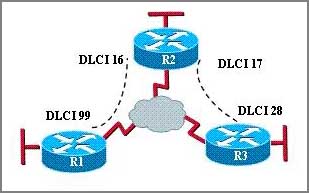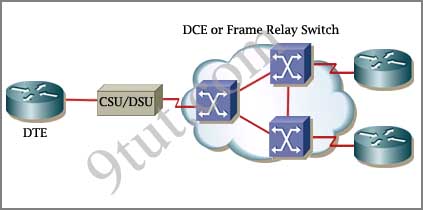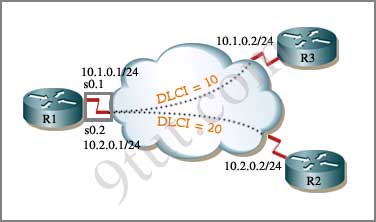CCNA – WAN
Here you will find answers to WAN Questions
If you are not sure about Frame Relay, please read my Frame Relay tutorial.
Question 1
The command frame-relay map ip 10.121.16.8 102 broadcast was entered on the router. Which of the following statements is true concerning this command?
A: This command should be executed from the global configuration mode.
B: The IP address 10.121.16.8 is the local router port used to forward data.
C: 102 is the remote DLCI that will receive the information.
D: This command is required for all Frame Relay configurations.
E: The broadcast option allows packets, such as RIP updates, to be forwarded across the PVC.
Correct Answers: E
Explanation:
The command frame-relay map ip 10.121.16.8 102 broadcast means to mapping the distal IP 10.121.16.8 102 to the local DLCI 102. When the “broadcast” keyword is included, it turns Frame Relay network as a broadcast network, which can forward broadcasts
Question 2
Refer to the exhibit. Which statement describes DLCI 17?

A: DLCI 17 describes the ISDN circuit between R2 and R3.
B: DLCI 17 describes a PVC on R2. It cannot be used on R3 or R1.
C: DLCI 17 is the Layer 2 address used by R2 to describe a PVC to R3.
D: DLCI 17 describes the dial-up circuit from R2 and R3 to the service provider.
Correct Answers: C
Explanation:
DLCI stands for Data Link Connection Identifier. DLCI values are used on Frame Relay interfaces to distinguish between different virtual circuits. DLCIs have local significance because the identifier references the point between the local router and the local Frame Relay switch to which the DLCI is connected.
Question 3
A default Frame Relay WAN is classified as what type of physical network?
A: point-to-point
B: broadcast multi-access
C: nonbroadcast multi-access
D: nonbroadcast multipoint
E: broadcast point-to-multipoint
Correct Answer: C
Explanation:
Non-Broadcast Multi-Access (NBMA) networks are types such as Frame Relay, X.25, and Asynchronous Transfer Mode (ATM). These networks allow for multi-access, but have no broadcast ability like Ethernet
Question 4
Which of the following are key characteristics of PPP? (Choose three.)
A: can be used over analog circuits
B: maps Layer 2 to Layer 3 address
C: encapsulates several routed protocols
D: supports IP only
E: provides error correction
Correct Answers: A C E
Explanation
Below is some more information about PPP:
PPP (Point-to-Point Protocol) allows authentication such as Password Authentication Protocol (PAP) and Challenge Handshake Authentication Protocol (CHAP) and multilink connections (allow several separate physical paths to appear to be one logical path at layer 3) and can be run over asynchronous and synchronous links.
PPP can work with numerous network layer protocols, including Internet Protocol (IP), Novell’s Internetwork Packet Exchange (IPX), NBF and AppleTalk.
PPP only supports error detection, not error correction so answer E should be understood as “provides error detection”. It is a mistake of this question.
Question 5
Which three Layer 2 encapsulation types would be used on a WAN rather than a LAN? (Choose three)
A: HDLC
B: Ethernet
C: Token Ring
D: PPP
E: FDDI
F: Frame Relay
Correct Answer: A D F
Question 6
Refer to the exhibit. What is the meaning of the term dynamic as displayed in the output of the show frame-relay map command shown?

A: The Serial0/0 interface is passing traffic.
B: The DLCI 100 was dynamically allocated by the router
C: The Serial0/0 interface acquired the IP address of 172.16.3.1 from a DHCP server
D: The DLCI 100 will be dynamically changed as required to adapt to changes in the Frame Relay cloud
E: The mapping between DLCI 100 and the end station IP address 172.16.3.1 was learned through Inverse ARP
Correct Answer: E
Explanation
The term dynamic indicates that the DLCI number and the remote router IP address 172.16.3.1 are learned via the Inverse ARP process.
Inverse ARP is a technique by which dynamic mappings are constructed in a network, allowing a device such as a router to locate the logical network address and associate it with a permanent virtual circuit (PVC).
Question 7
Which of the following describes the roles of devices in a WAN? (Choose three.)
A: A CSU/DSU terminates a digital local loop
B: A modem terminates a digital local loop
C: A CSU/DSU terminates an analog local loop
D: A modem terminates an analog local loop
E: A router is commonly considered a DTE device
F: A router is commonly considered a DCE device
Correct Answers: A D E
Explanation
The idea behind a WAN is to be able to connect two DTE networks together through a DCE network. The network’s DCE device (includes CSU/DSU) provides clocking to the DTE-connected interface (the router’s serial interface).

A modem modulates outgoing digital signals from a computer or other digital device to analog signals for a conventional copper twisted pair telephone line and demodulates the incoming analog signal and converts it to a digital signal for the digital device. A CSU/DSU is used between two digital lines -> A & D are correct but B & C are not correct.
For more explanation of answer D, in telephony the local loop (also referred to as a subscriber line) is the physical link or circuit that connects from the demarcation point of the customer premises to the edge of the carrier or telecommunications service provider’s network. Therefore a modem terminates an analog local loop is correct.

Question 8
How should a router that is being used in a Frame Relay network be configured to avoid split horizon issues from preventing routing updates?
A: Configure a separate sub-interface for each PVC with a unique DLCI and subnet assigned to the sub-interface
B: Configure each Frame Relay circuit as a point-to-point line to support multicast and broadcast traffic
C: Configure many sub-interfaces on the same subnet
D: Configure a single sub-interface to establish multiple PVC connections to multiple remote router interfaces
Correct Answer: A
Explanation
Look at the figure below:

In the figure, router R1 has two point-to-point subinterfaces. The s0.1 subinterface connects to router R3 and the s0.2 subinterface connects to router R2. Each subinterface is on a different subnet.
Question 9
What can a network administrator utilize by using PPP Layer 2 encapsulation? (Choose three.)
A: VLAN support
B: compression
C: authentication
D: sliding windows
E: multilink support
F: quality of service
Correct Answers: B C E
Explanation
Same as question 4
Question 10
The Frame Relay network in the diagram is not functioning properly. What is the cause of the problem?

A: The Gallant router has the wrong LMI type configured
B: Inverse ARP is providing the wrong PVC information to the Gallant router
C: The S3 interface of the Steele router has been configured with the frame-relay encapsulation ietf command
D: The frame-relay map statement in the Attalla router for the PVC to Steele is not correct
E: The IP address on the serial interface of the Attalla router is configured incorrectly
Correct Answer: D
Explanation
At Attalla router, we find a deleted status but the next map statement indicates an active status, which if for Gallant. Therefore we can deduce the map statement for the PVC from Attalla to Steele is incorrect. Incorrect DLCI assignments that are configured normally shown up as “deleted” in the frame relay maps.



PLZ some 1 help me answer this Q as shown in the pic
http://img104.herosh.com/2011/11/30/685514061.jpg
i can’t understand why the choice isn’t B ??
as dump say it is C !!
thnx
@Ranjitha
What is your Q exactly ??
as i know DLCI is locally significant isn’t it ?
i’ll reply for you
@Ranjitha
Q8.
The frame-relay configuration above is a typically hub and spoke topology.
This kind of topology or configuration usually have split horizon issues, which prevent routing updates.
To avoid split horizon is issues:
Configure a separate sub-interface for each PVC with a unique DLCI and subnet assigned to the sub-interface.
This is all there is to it. Hope this helps.Thanks.
@Ranjitha
My bad…..Correction………….To avoid split horizon issues:
@ Koffy and @ Eng-support
The correct answer for my question is :
*Show framerelay map
@Jawad i’m not sure about that :(
PLZ some 1 help me answer this Q as shown in the pic
http://img104.herosh.com/2011/11/30/685514061.jpg
i can’t understand why the choice isn’t B ??
as dump say it is C !!
thnx
@Eng-Support
they’re on a same subnet. 255.255.248.0 stays for 10.0.8-15 networks.
A and D definately incorrect.
I’ve explained D is incorrect too.
so C is the answer.
@TLN
what is password & usernames really affects the connectivity ??? !!!!
thnx to you
@Eng-Support
Only if you use any type of authentication.
Example in ppp, the comunications steps are three:
First: the LCP starts the sesion among the two ends of the WAN link
Second: also know as, optional-phase, if there is authentication configured, in this phase is to be required the username and the password, if there isn’t a authentication configured the comunication process makes a bypass to de final step.
Finally: the NCP establishes the “comunication” among the layer 2 protocol with the higher protocols.
@xallax
Can you explain Q7 in detail ?
How modem terminates analog local loop and how DSU/CU Terminates digital local loop ?
@anonymous
keyword “analog” refers to the telephone line. modems connect your router (or any other device) to the telephone line
a CSU/DSU set the clock rate for the serial link from your router to the ISP and connects the 2 routers together.
“A CSU/DSU (Channel Service Unit/Data Service Unit) is a hardware device about the size of an external modem that converts digital data frames from the communications technology used on a local area network (LAN) into frames appropriate to a wide-area network (WAN) and vice versa.”
http://en.wikipedia.org/wiki/CSU/DSU
Someone give me the correct answer for this question:
what algorithme technologie must be used for ensuring data integrity when dataflow goes over VPN tunnel ?
1 RSA
2 DH-1
3 DH-2
4 HMAC-MD5
5 HMAC-SHA1
thanks
@jawad
sha1 and md5
question 6 frumos:
http://www.9tut.com/ccna-security-questions
cheers
thanks xallax
please can anyone tell me how long does a dump last.
about Q9
I don’t understand option B, please explain for me.
thanks!
sorry because my Eng.
@kindrock
ppp compresses data so it gives us more throughput and less bw usage.
@Ahmed
thanks!
ABOUT Q4, error detection is different from error correction, how can we have such a mistake in a serious exams like ccna?
Please can someone send me ccna dump. I am talking my ccna exam by april 2012. My emial usman4everybody@yahoo.com thanks
Hello Everybody,
Can anyone send me the latest dumps of CCNA because i have scheduled my paper on 31st jan, 2012.. Please help..my email id is hasanshahbazi@gmail.com
Thanks
pz pz pz pz send me latest dumps of ccna urgent …to my mail id
rameshprabhu2@gmail.com
Pls share with me the latest dumps of CCNA because i have scheduled my paper on 3rd Feb, 2012
ariya2507@yahoo.com
Can anyone send me the latest dumps of CCNA — please
ghali_magdi@yahoo.com
which command allows you to verify the encapsulation type(Cisco; Ietf) :
1*show framerelay map
2*show framerelay lmi
3*show framerelay pvc
4*show inter serial
right opti0n in dumps is 4 ,but i can bet its wr0ng,it sh0uld be 2.@9tut please thr0w s0me light 0n it .
show interface serial interface-type number
The show interface serial privileged EXEC mode command displays detailed information of a physical interface or a subinterface. The information shown by the show interface serial command offers the following information on Frame Relay:
The type of Frame Relay encapsulation used on an interface or PVC
The keepalive interval configured
The Frame Relay LMI type used
The status of Frame Relay LMI
Information on whether the interface is configured as a Frame Relay DTE or a DCE device
Hi 9tut… Hi Guys! Can you please help me… I will take exam this Feb. Please send me latest dump so that I will have an idea for the exam.. rico.blake@ymail.com
Thanks Guys!
hi,
what do you think, what is the right answer?
What is the result of issuing the frame-relay map ip 192.168.1.2 202 broadcast command? A.defines the DLCI that is used for all packets that are sent to the 192.168.1.2 IP address B.defines the source IP address that is used in all broadcast packets on DCLI 202
C.defines the DLCI on which packets from the 192.168.1.2 IP address are received
D.defines the destination IP address that is used in all broadcast packets on DCLI 202
I think it is A, but i found that it is D
thx
@9tut : Can you please explain the below commands. I am unable to differentiate between them.
1. show framerelay map
2. show framerelay lmi
3. show framerelay pvc
@Anjali:L You should learn the concept of LMI, PVC first then you can understand these commands easily. You can read them here: http://www.9tut.com/frame-relay-tutorial
why in a trame hdlc,ppp or frame relay , they don’t have a mac address destintion or source ?
@Lara
because they have a DLCI “Locally significant”
stands for “Data Link Connection Identifier”
hope to be useful for you
thanks
latest dumps :-
http://www.examcollection.com/cisco/Cisco.PrepKing.640-802.v2012-01-03.by.DHARANI.615q.vce.file.html
&
http://www.examcollection.com/cisco/Cisco.Acme.640-802.v2011-07-09.by.Collisio.486q.vce.file.html
@ support
BIG TK
I cannot get to the examcollection.com website. Is anyone else having problems with getting to this site?
I have noticed that many people just give their email address for the dumps. Do people really receive dumps in email?
@9tut: @Xallax: In WAN, except BSS and ESS, any thing like IBSS is exist??.. I have read somewhere in dump.
Wireless communications directly between your laptops, called IBSS Topology.
Please correct.
@arpit
you are referring to WLAN, not to WAN.
the type of connection you’ve read about is called ad-hoc
please read some more here:
http://www.9tut.com/wireless-tutorial
thank you
@9TUT
Which one is the best answer?
Refer to the exhibit. In the communication between host 1 and host 2 over the point-to-point WAN, which protocol or technology is represented by dashed line A?
PC1 ———————— PC2
SW1 ———————– SW2
R1 ————————- R2
CSU/DSU ——————- CSU/DSU
A. IP
B.T1
C. PPP
D. IEEE 802.3
Thanks.
@anonymous
PCs “talk” using IP. answer is A
Pls share with me the latest latest dumps of CCNA because i have scheduled on 25th March, 2012
zahmif@yahoo.com
answers below seem incorrect:
#
jawad
November 30th, 2011
Hi all someone give me the correct answer for this question:
wich command allows you to verify the encapsulation type(Cisco; Ietf) :
1*show framerelay map
2*show framerelay lmi
3*show framerelay pvc
4*show inter serial
PLz and thanks
#
Koffy
November 30th, 2011
@jawad
option4. “show inter serial”
#
Eng-Support
November 30th, 2011
@Jawad i think it is answer 4 but it must followed by serial interface number
#sh int serial 0/1
hope to be not confused
The correct answer IMO is: 1*show frame-relay map
may I knw abt d laTest simulations? plzz some one update dat
pls can someone help me with latest ccna dump.send to ann_sweet8@yahoo.com Thanks in advance.
Anonymous is right, the correct answer is 1*show frame-relay map
Taken from Cisco website:
Router# show frame-relay map
Serial 1 (administratively down): ip 131.108.177.177
dlci 177 (0xB1,0x2C10), static,
broadcast,
CISCO
TCP/IP Header Compression (inherited), passive (inherited)
—————————————————————————————————-
show frame-relay map Field Descriptions
CISCO : Indicates the encapsulation type for this map; either CISCO or IETF.
Can someone please expalin me more about on the link bellow.
http://dl.dropbox.com/u/59575250/Q34.JPG
Thnx b4.
Hi 9tut & Xallax.I have question.
1.Why is it called Frame Relay rather that Packet Relay because they using IP and it passing through routers…
2. Is PPP is only for leased line?
3. Is HDLC automatically enabled between cisco devices?
a. IS CSU/DSU and Modem are the same? or THey have their own capabilities?
b. IS there any explanation or technical definition about DCE and DTE coz all I know is DcE is ISP side that set clock rate and DTE is on customer side.
Thanks in Advance 9tut.THis is a great site!
please provide me latest CCNA dumps if anybody has. Please mail me to kshivam@rediffmail.com